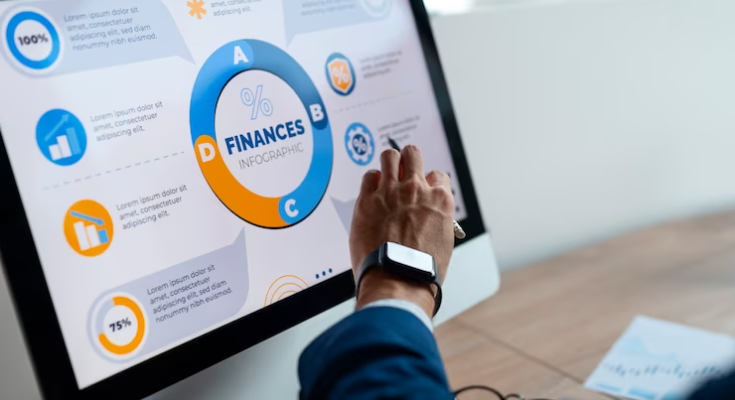There is a revolution taking place in several industries. That’s all thanks to one thing; artificial intelligence —-commonly called AI.
Today, brands (especially in the finance industry) leverage AI to solve everyday problems. With it, finance experts can now access faster, more innovative, and more affordable solutions to complex problems.
Based on projections by Grand View Research, the value of the AI market could surpass $407 billion by 2027. The current expansion indicates growing interest in and integration of AI solutions throughout diverse industries and areas of focus.
However, this technology may only be able to solve a portion of the financial problems and opportunities.
So, in the subsequent sections, you will learn how to use AI as a finance expert in 2023 and beyond to optimize its efficiency.
How To Use AI As A Finance Expert In 2023

Enhance Data-Driven Finance
For any financial organization, information serves as the building blocks of success. By offering a thorough framework for assessment, historical data facilitates forecasting of future market developments.
In this context, having solely relied on statistics might fall short in navigating modern financial spheres successfully. And so, finance experts ought to capitalize on financial AI tools to achieve peak productivity.
These tools make multiple responsibilities easier and faster, thus increasing your productivity and precision.
Here are examples of how this happens:
1. Data Analysis
Data analysis has one primary purpose:
To help you derive meaningful findings, reach logical conclusions, and back up your choice-making with evidence.
It uses data training software to provide advanced data readiness, streamlining processes before the deployment of a model.
You can use this software to refine, categorize, expand, and convert information to facilitate machine learning frameworks.
This feature optimizes algorithm selection and parameter configuration according to available data and goals.
2. Forecasting
Forecasting involves constructing statistical frameworks based on past events and current conditions. Through extensive data evaluation, machine learning models revolutionize how financial transactions run smoothly.
Reliable conclusions open doors to growth in the future.
Repetition enables them to hone their predictions through data pattern analysis. By streamlining the process of analyzing large datasets, these advanced instruments grant you the enhanced capacity to identify hidden but critical insights with minimal hassle.
Through machine learning processing, these models aid in estimating or forecasting by referencing historical information.
For instance, Zest AI employs artificial intelligence to comprehensively evaluate factors affecting loan seekers’ credit ratings, facilitating informed lending decisions among financial bodies.
Enhance Investment Decisions With AI

A key aspect of fiscal responsibility lies in strategic allocation across diverse investment channels like stocks, gold IRAs, and more.
Although your taste carries weight, it isn’t the ultimate determinant of investment strategies.
Enhancing investment decisions through artificial intelligence yields increased profitability for your portfolio.
Here is an example of how this happens:
1. Algorithmic Trading And Quantitative Analysis
Through the integration of AI, investors may build intelligent methods driven by established principles or complex numerical computations specifically intended to carry out trades with optimal results.
Mathematical methods and statistical approaches help this tool examine financial data, resulting in actionable findings, forecasts, or counsel.
An example of a tool that does this is DataRobot. It is a prime model of data training tool with robust functionality for seamless machine learning model creation and integration into algorithmic trading workflows.
Zest AI is another example that uses countless data points to analyze borrowers’ risk profiles and develop an artificial intelligence framework specifically designed for banks.
2. Sentiment Analysis To Predict Market Trends
AI assesses the market’s mood, customer base, rival businesses, regulatory environment, and investor perceptions.
It analyzes and understands texts or spoken words from diverse sources like articles, online posts, reviews, and more. Moreover, these insights enable investors to predict upcoming trends and possibilities based on the gathered information.
For example, using sentiment analysis, AB Tasty (a sentimental analysis company) grants customers broader access to vast databases. It facilitates better decisions leading to enhanced client income.
Mitigate Risks Through AI

Managing risk in today’s multifaceted and fast-paced world can be challenging and time-consuming.
In particular, it is true when you use outdated data and separate data sets.
But there is a way you can get around this:
Automation can streamline risk management workflows by simplifying tasks through an automated process.
AI can alleviate these dangers in different ways.
For example, you can use it to:
1. Identify Potential Risks Using Predictive Analytics
Predictive technologies powered by data analysis and machine learning enable AI to detect and prepare against possible threats.
Using predictive analytics, financial professionals evaluate the possibility and implications of numerous dangers, including stock exchange volatility, loan default, operational malfunction, and cyber assault, among others.
2. Detect And Prevent Fraud With Anomaly Detection
Anomalies detected through AI-assisted methods enable effective fraud prevention strategies. Data analysis detects abnormal or questionable patterns and actions.
Through this process, suspicious activities will reveal themselves due to inconsistencies detected by anomaly detection.
Conclusion
There is an expected significant increase in AI usage across various industries by 2023.
And one industry that isn’t falling behind is finance. And so finance experts are leaving no room for complacency.
With this fast proliferation, you may find learning or using it challenging. Fortunately, you can use advanced AI coupled with the ideas above to make informed choices.
If you do so, you can solve your problems faster, more intelligently, and cost-effectively.




